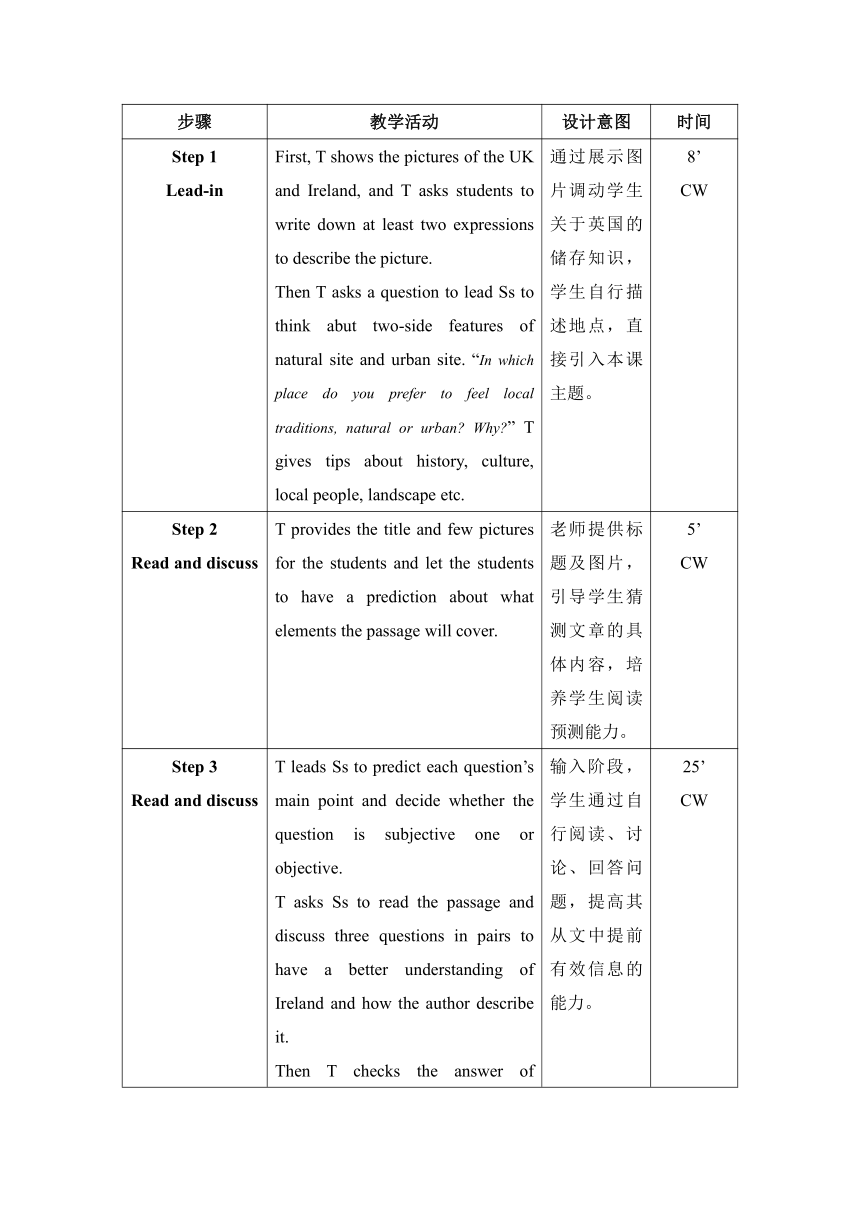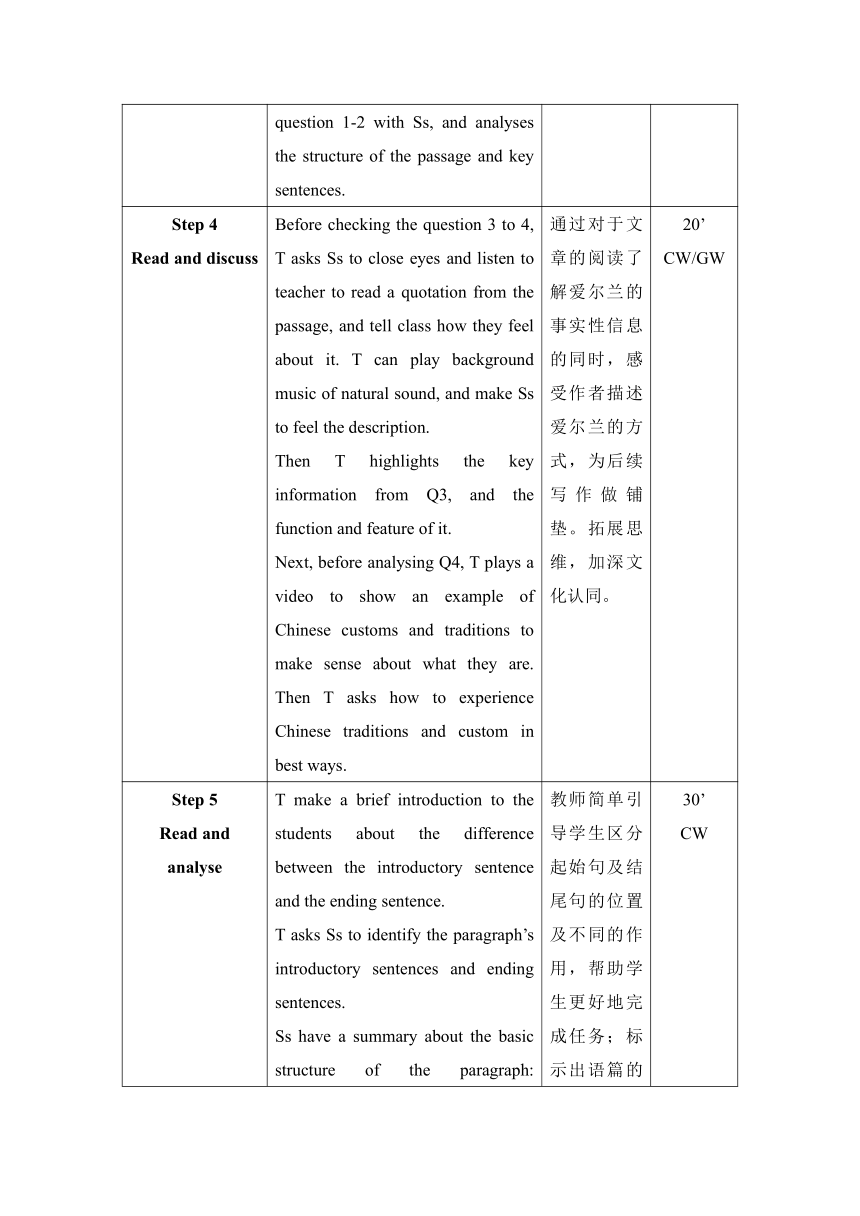人教版(2019)必修第二册Unit 4 History and Tradition Reading for Writing教案(表格式)
文档属性
| 名称 | 人教版(2019)必修第二册Unit 4 History and Tradition Reading for Writing教案(表格式) |  | |
| 格式 | docx | ||
| 文件大小 | 19.2KB | ||
| 资源类型 | 教案 | ||
| 版本资源 | 人教版(2019) | ||
| 科目 | 英语 | ||
| 更新时间 | 2024-04-02 09:53:16 | ||
图片预览



文档简介
Unit 4 History and Tradition
Reading for Writing教案
教材分析:
本课时主要包含一篇阅读文本,一篇描述爱尔兰的文章,包括其自然风景及其历史文化传统,学生通过学习了解爱尔兰的风土人情,其中细节描写较多,运用大量感官相关词汇,调用了读者多个感官,学生通过阅读,学习如何精细地描写一个地点,了解英语文章结构的引入、主体、结尾的形式。
教学策略与设计说明:
采用任务型教学法(Task-based language teaching),布置活动任务,设置活动目的,引导学生完成相关任务,达成各个教学步骤的设计目的。
教学目标:
在本课学习结束时,学生能够:
语言能力上,掌握地点细节描写的相关词汇,准确运用于写作,细节化地描写地点,了解英语文章的基本结构。
思维品质上,获取文中描述感觉的语言及方式,了解地点描述从大方向往细节的结构模式及原因。
文化品格上,体会爱尔兰的部分自然及历史文化特征,对比中西传统习俗,形成对自己国家的认同。
学习能力上,学会细节化地描写地点,准确运动感官类词汇进行描绘,能够对他人的文章进行评阅,学习制作新。
教学重点:
获取有关爱尔兰的事实性信息,梳理出文章的结构;
获取文章中描述感受的的语言并模仿写作。
教学难点:
模仿文章中表达感受的语言,正确运用到写作当中,描述一个自己喜欢的地点。
准确评阅他人所写的文章。
教学资源:黑板、粉笔、多媒体
教学过程:
步骤 教学活动 设计意图 时间
Step 1 Lead-in First, T shows the pictures of the UK and Ireland, and T asks students to write down at least two expressions to describe the picture. Then T asks a question to lead Ss to think abut two-side features of natural site and urban site. “In which place do you prefer to feel local traditions, natural or urban Why ” T gives tips about history, culture, local people, landscape etc. 通过展示图片调动学生关于英国的储存知识,学生自行描述地点,直接引入本课主题。 8’ CW
Step 2 Read and discuss T provides the title and few pictures for the students and let the students to have a prediction about what elements the passage will cover. 老师提供标题及图片,引导学生猜测文章的具体内容,培养学生阅读预测能力。 5’ CW
Step 3 Read and discuss T leads Ss to predict each question’s main point and decide whether the question is subjective one or objective. T asks Ss to read the passage and discuss three questions in pairs to have a better understanding of Ireland and how the author describe it. Then T checks the answer of question 1-2 with Ss, and analyses the structure of the passage and key sentences. 输入阶段,学生通过自行阅读、讨论、回答问题,提高其从文中提前有效信息的能力。 25’ CW
Step 4 Read and discuss Before checking the question 3 to 4, T asks Ss to close eyes and listen to teacher to read a quotation from the passage, and tell class how they feel about it. T can play background music of natural sound, and make Ss to feel the description. Then T highlights the key information from Q3, and the function and feature of it. Next, before analysing Q4, T plays a video to show an example of Chinese customs and traditions to make sense about what they are. Then T asks how to experience Chinese traditions and custom in best ways. 通过对于文章的阅读了解爱尔兰的事实性信息的同时,感受作者描述爱尔兰的方式,为后续写作做铺垫。拓展思维,加深文化认同。 20’ CW/GW
Step 5 Read and analyse T make a brief introduction to the students about the difference between the introductory sentence and the ending sentence. T asks Ss to identify the paragraph’s introductory sentences and ending sentences. Ss have a summary about the basic structure of the paragraph: introductory sentence, body, ending sentence. T asks students to write down the senses and places with their appearing order. Next T asks Ss to think about the differences between a common sentence and a sentence with sensory details. T shows a picture from Stanislav Brusilov (Russia) for helping Ss understand the meaning of sensory sentences easily. Ss can feel the sight, hearing, smell, touch etc. from the picture alike sensory sentences in a passage. Lastly, T leads to Ss to think about how to use sensory sentences in our writing. 教师简单引导学生区分起始句及结尾句的位置及不同的作用,帮助学生更好地完成任务;标示出语篇的第一句及最后一句,引导学生形成寻找总领句及总结句的习惯;学生通过写下感觉及地点的词汇,对于作者对爱尔兰的描述有更明确的了解。通过感受画面,提高对于写作方式的理解,从而提高学习能力。 30’ CW
Step 6 Writing Ss work in pairs for 10 mins to choose one place and give reasons for why they like it. T gives six questions for students to consider. 学生为引入过程中选择的地点重新选择更为细节化的描述词,教师通过问题给予学生思考的方向。 15’ GW
Step 7 Writing Ss draft their own passage with what they have learned in the class before. T provides a chart for the students to imitate and better understand the composition of a passage. 老师展示并引导学生进一步了解地点描述细节化描写的方法,为学生搭建脚手架;学生根据课堂所学撰写第一稿,教师提供文章结构的参考,使学生对于英文文章结构有更深的了解。 15’ IW
Step 8 Evaluate Ss exchange their drafts and use the checklist to give a feedback on their partners’ drafts. 为学生互评提供评价标准,使得评价更加客观。 10’ GW
Step 9 Revising Ss get their drafts back and revise them according to the advice provided by T. 根据修改提示,清晰修改步骤;在同伴建议的基础上再次修正文稿,使其更加完善。 8’ IW
Step 10 Show time 1. Teacher have an explanation for the “class book” and help students better understand the requirements of the task. 2.Ss put up their passage in the classroom or read them to the class. 学生在课堂上展示其文章,增强学生的自信及体现写作产出的重要性; 学习和了解制作纪念册,锻炼学生接受和制作新事物的能力。 10’ CW
Step 11 Key words T teaches the key words that occurred in the letter by presenting pictures and gives some examples. 通过图片和例子对重点词汇讲解,增强词汇学习的有效性。 6’ CW
Step 12 Homework Use the checklist to improve your paragraph you have finished in class and write a description for your hometown. 为学生提供可选择的不同难度的作业,巩固课堂所学,掌握地点的描述方式。 1’ IW
备注:T: Teacher Ss: Students
IW: Individual work GW: Group work CW: Class work
教学反思:
学生通过本课时学习,能否熟练掌握地点细节描写的相关词汇,并将其运用于写作中。
学生通过本课时学习,能否了解爱尔兰的自然及历史文化特征。
学生通过本课时学习,能否学会细节化地描写地点,准确运动感官类词汇进行描绘,并且能够对他人的文章进行评阅。
Reading for Writing教案
教材分析:
本课时主要包含一篇阅读文本,一篇描述爱尔兰的文章,包括其自然风景及其历史文化传统,学生通过学习了解爱尔兰的风土人情,其中细节描写较多,运用大量感官相关词汇,调用了读者多个感官,学生通过阅读,学习如何精细地描写一个地点,了解英语文章结构的引入、主体、结尾的形式。
教学策略与设计说明:
采用任务型教学法(Task-based language teaching),布置活动任务,设置活动目的,引导学生完成相关任务,达成各个教学步骤的设计目的。
教学目标:
在本课学习结束时,学生能够:
语言能力上,掌握地点细节描写的相关词汇,准确运用于写作,细节化地描写地点,了解英语文章的基本结构。
思维品质上,获取文中描述感觉的语言及方式,了解地点描述从大方向往细节的结构模式及原因。
文化品格上,体会爱尔兰的部分自然及历史文化特征,对比中西传统习俗,形成对自己国家的认同。
学习能力上,学会细节化地描写地点,准确运动感官类词汇进行描绘,能够对他人的文章进行评阅,学习制作新。
教学重点:
获取有关爱尔兰的事实性信息,梳理出文章的结构;
获取文章中描述感受的的语言并模仿写作。
教学难点:
模仿文章中表达感受的语言,正确运用到写作当中,描述一个自己喜欢的地点。
准确评阅他人所写的文章。
教学资源:黑板、粉笔、多媒体
教学过程:
步骤 教学活动 设计意图 时间
Step 1 Lead-in First, T shows the pictures of the UK and Ireland, and T asks students to write down at least two expressions to describe the picture. Then T asks a question to lead Ss to think abut two-side features of natural site and urban site. “In which place do you prefer to feel local traditions, natural or urban Why ” T gives tips about history, culture, local people, landscape etc. 通过展示图片调动学生关于英国的储存知识,学生自行描述地点,直接引入本课主题。 8’ CW
Step 2 Read and discuss T provides the title and few pictures for the students and let the students to have a prediction about what elements the passage will cover. 老师提供标题及图片,引导学生猜测文章的具体内容,培养学生阅读预测能力。 5’ CW
Step 3 Read and discuss T leads Ss to predict each question’s main point and decide whether the question is subjective one or objective. T asks Ss to read the passage and discuss three questions in pairs to have a better understanding of Ireland and how the author describe it. Then T checks the answer of question 1-2 with Ss, and analyses the structure of the passage and key sentences. 输入阶段,学生通过自行阅读、讨论、回答问题,提高其从文中提前有效信息的能力。 25’ CW
Step 4 Read and discuss Before checking the question 3 to 4, T asks Ss to close eyes and listen to teacher to read a quotation from the passage, and tell class how they feel about it. T can play background music of natural sound, and make Ss to feel the description. Then T highlights the key information from Q3, and the function and feature of it. Next, before analysing Q4, T plays a video to show an example of Chinese customs and traditions to make sense about what they are. Then T asks how to experience Chinese traditions and custom in best ways. 通过对于文章的阅读了解爱尔兰的事实性信息的同时,感受作者描述爱尔兰的方式,为后续写作做铺垫。拓展思维,加深文化认同。 20’ CW/GW
Step 5 Read and analyse T make a brief introduction to the students about the difference between the introductory sentence and the ending sentence. T asks Ss to identify the paragraph’s introductory sentences and ending sentences. Ss have a summary about the basic structure of the paragraph: introductory sentence, body, ending sentence. T asks students to write down the senses and places with their appearing order. Next T asks Ss to think about the differences between a common sentence and a sentence with sensory details. T shows a picture from Stanislav Brusilov (Russia) for helping Ss understand the meaning of sensory sentences easily. Ss can feel the sight, hearing, smell, touch etc. from the picture alike sensory sentences in a passage. Lastly, T leads to Ss to think about how to use sensory sentences in our writing. 教师简单引导学生区分起始句及结尾句的位置及不同的作用,帮助学生更好地完成任务;标示出语篇的第一句及最后一句,引导学生形成寻找总领句及总结句的习惯;学生通过写下感觉及地点的词汇,对于作者对爱尔兰的描述有更明确的了解。通过感受画面,提高对于写作方式的理解,从而提高学习能力。 30’ CW
Step 6 Writing Ss work in pairs for 10 mins to choose one place and give reasons for why they like it. T gives six questions for students to consider. 学生为引入过程中选择的地点重新选择更为细节化的描述词,教师通过问题给予学生思考的方向。 15’ GW
Step 7 Writing Ss draft their own passage with what they have learned in the class before. T provides a chart for the students to imitate and better understand the composition of a passage. 老师展示并引导学生进一步了解地点描述细节化描写的方法,为学生搭建脚手架;学生根据课堂所学撰写第一稿,教师提供文章结构的参考,使学生对于英文文章结构有更深的了解。 15’ IW
Step 8 Evaluate Ss exchange their drafts and use the checklist to give a feedback on their partners’ drafts. 为学生互评提供评价标准,使得评价更加客观。 10’ GW
Step 9 Revising Ss get their drafts back and revise them according to the advice provided by T. 根据修改提示,清晰修改步骤;在同伴建议的基础上再次修正文稿,使其更加完善。 8’ IW
Step 10 Show time 1. Teacher have an explanation for the “class book” and help students better understand the requirements of the task. 2.Ss put up their passage in the classroom or read them to the class. 学生在课堂上展示其文章,增强学生的自信及体现写作产出的重要性; 学习和了解制作纪念册,锻炼学生接受和制作新事物的能力。 10’ CW
Step 11 Key words T teaches the key words that occurred in the letter by presenting pictures and gives some examples. 通过图片和例子对重点词汇讲解,增强词汇学习的有效性。 6’ CW
Step 12 Homework Use the checklist to improve your paragraph you have finished in class and write a description for your hometown. 为学生提供可选择的不同难度的作业,巩固课堂所学,掌握地点的描述方式。 1’ IW
备注:T: Teacher Ss: Students
IW: Individual work GW: Group work CW: Class work
教学反思:
学生通过本课时学习,能否熟练掌握地点细节描写的相关词汇,并将其运用于写作中。
学生通过本课时学习,能否了解爱尔兰的自然及历史文化特征。
学生通过本课时学习,能否学会细节化地描写地点,准确运动感官类词汇进行描绘,并且能够对他人的文章进行评阅。
